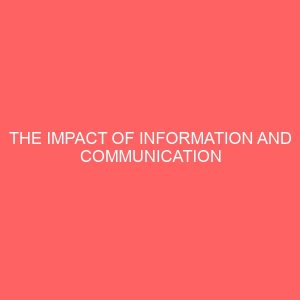Description
ABSTRACT
Budgeting has been useful to all organization. It guides the management of organization in decision making. Management really on budgeting information to frequently provide operating information. These operating information aid management in directing day to day operation and also provide feedback to available and control performance. Budgeting information enables the management of CrossRive State Newspaper Corporation to determine the unit cost of is products and cost of operation of the corporation. It provides information which could and the management of the Newspaper corporation to make decision, such as recruitment, sales/distribution of its products, it enable the evaluation of performance, it guides in the formulation of future polices and also gives a warning signal to management to take appropriate action against over spending and other expenditure.
Cross River State Newspaper Corporation has a good budgeting information system with good management team which always cooperation with budget department to implement budget document according to the set out goals of the corporation.
The problem of the corporation is not from its budgeting system, but inadequate finance to implement budgeting information.
TABLE OF CONTENTS
CERTIFICATION
DEDICATION
ACKNOWLEDGMENT
ABSTRACT
TABLE OF CONTENTS
CHAPTER ONE
1.0 Introduction 1
1.1 Background to the study 1
1.2 Statement of problem 2
1.3 Research objectives 4
1.4 Research question 4
1.5 Significance of the study 5
1.6 Scope of the study 5
1.7 Definition of terms5
CHAPTER TWO LITERATURE
2.0 Introduction9
2.1 Review of works done by others on the topic10
2.2 Meaning of budgeting 10
2.3 Types of budgets 12
2.4 Classification of budgeting16
2.5 Budget preparation20
2.6 Purposes of budget preparation20
2.7 Decision centre for management.21
2.8 Function of budgeting22
2.9 uses of budgeting for management decision making 22
2.10 Objectives of budgeting control24
2.11 Brief of profile of CRS Newspaper Corporation24
CHAPTER THREERESEARCH DESIGN AND METHODOLOGY
3.0 Introduction 28
3.1 Research design28
3.2 Sample size and sampling Techniques 28
3.3 Method s of data collection 29
3.4 Tools of data Analysis 30
3.5 Weakness of Methodology 30
CHAPTER FOURDATA PRESENTATION, ANALYSIS
4.0 Introduction 32
4.1 Data Presentation33
4.2 Analysis of data38
4.3 Analysis of findings41
CHAPTER FIVESUMMARY CONCLUSION AND RECOMMENDATION
5.0 Introduction44
5.1 Summary44
5.2 Conclusion 45
5.3 limitation of the study47
5.4 Recommendations47
Bibliography49
Appendixes 51
Questionnaires 52








Reviews
There are no reviews yet.